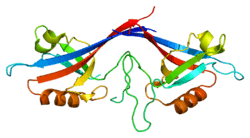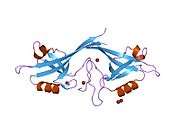SHANK1
| View/Edit Human | View/Edit Mouse |
SH3 and multiple ankyrin repeat domains protein 1 is a protein that in humans is encoded by the SHANK1 gene.[3][4]
Interactions
SHANK1 has been shown to interact with:
References
- ↑ "Human PubMed Reference:".
- ↑ "Mouse PubMed Reference:".
- 1 2 Zitzer H, Hönck HH, Bächner D, Richter D, Kreienkamp HJ (January 2000). "Somatostatin receptor interacting protein defines a novel family of multidomain proteins present in human and rodent brain". J Biol Chem. 274 (46): 32997–3001. doi:10.1074/jbc.274.46.32997. PMID 10551867.
- ↑ "Entrez Gene: SHANK1 SH3 and multiple ankyrin repeat domains 1".
- ↑ Park E, Na M, Choi J, Kim S, Lee JR, Yoon J, Park D, Sheng M, Kim E (May 2003). "The Shank family of postsynaptic density proteins interacts with and promotes synaptic accumulation of the beta PIX guanine nucleotide exchange factor for Rac1 and Cdc42". J. Biol. Chem. 278 (21): 19220–9. doi:10.1074/jbc.M301052200. PMID 12626503.
- ↑ Soltau M, Richter D, Kreienkamp HJ (Dec 2002). "The insulin receptor substrate IRSp53 links postsynaptic shank1 to the small G-protein cdc42". Mol. Cell. Neurosci. 21 (4): 575–83. doi:10.1006/mcne.2002.1201. PMID 12504591.
- ↑ Okamoto PM, Gamby C, Wells D, Fallon J, Vallee RB (Dec 2001). "Dynamin isoform-specific interaction with the shank/ProSAP scaffolding proteins of the postsynaptic density and actin cytoskeleton". J. Biol. Chem. 276 (51): 48458–65. doi:10.1074/jbc.M104927200. PMC 2715172
 . PMID 11583995.
. PMID 11583995. - ↑ Böckers TM, Mameza MG, Kreutz MR, Bockmann J, Weise C, Buck F, Richter D, Gundelfinger ED, Kreienkamp HJ (October 2001). "Synaptic scaffolding proteins in rat brain. Ankyrin repeats of the multidomain Shank protein family interact with the cytoskeletal protein alpha-fodrin". J. Biol. Chem. 276 (43): 40104–12. doi:10.1074/jbc.M102454200. PMID 11509555.
Further reading
- Sheng M, Kim E (2000). "The Shank family of scaffold proteins.". J. Cell. Sci. 113 (11): 1851–6. PMID 10806096.
- Naisbitt S, Kim E, Tu JC, Xiao B, Sala C, Valtschanoff J, Weinberg RJ, Worley PF, Sheng M (1999). "Shank, a novel family of postsynaptic density proteins that binds to the NMDA receptor/PSD-95/GKAP complex and cortactin.". Neuron. 23 (3): 569–82. doi:10.1016/S0896-6273(00)80809-0. PMID 10433268.
- Tu JC, Xiao B, Naisbitt S, Yuan JP, Petralia RS, Brakeman P, Doan A, Aakalu VK, Lanahan AA, Sheng M, Worley PF (1999). "Coupling of mGluR/Homer and PSD-95 complexes by the Shank family of postsynaptic density proteins.". Neuron. 23 (3): 583–92. doi:10.1016/S0896-6273(00)80810-7. PMID 10433269.
- Tobaben S, Südhof TC, Stahl B (2000). "The G protein-coupled receptor CL1 interacts directly with proteins of the Shank family.". J. Biol. Chem. 275 (46): 36204–10. doi:10.1074/jbc.M006448200. PMID 10958799.
- Kreienkamp HJ, Zitzer H, Gundelfinger ED, Richter D, Bockers TM (2000). "The calcium-independent receptor for alpha-latrotoxin from human and rodent brains interacts with members of the ProSAP/SSTRIP/Shank family of multidomain proteins.". J. Biol. Chem. 275 (42): 32387–90. doi:10.1074/jbc.C000490200. PMID 10964907.
- Kreienkamp HJ, Zitzer H, Richter D (2001). "Identification of proteins interacting with the rat somatostatin receptor subtype 2.". J. Physiol. Paris. 94 (3–4): 193–8. doi:10.1016/S0928-4257(00)00204-7. PMID 11087996.
- Lim S, Sala C, Yoon J, Park S, Kuroda S, Sheng M, Kim E (2001). "Sharpin, a novel postsynaptic density protein that directly interacts with the shank family of proteins". Mol. Cell. Neurosci. 17 (2): 385–97. doi:10.1006/mcne.2000.0940. PMID 11178875.
- Böckers TM, Mameza MG, Kreutz MR, Bockmann J, Weise C, Buck F, Richter D, Gundelfinger ED, Kreienkamp HJ (2001). "Synaptic scaffolding proteins in rat brain. Ankyrin repeats of the multidomain Shank protein family interact with the cytoskeletal protein alpha-fodrin". J. Biol. Chem. 276 (43): 40104–12. doi:10.1074/jbc.M102454200. PMID 11509555.
- Okamoto PM, Gamby C, Wells D, Fallon J, Vallee RB (2002). "Dynamin isoform-specific interaction with the shank/ProSAP scaffolding proteins of the postsynaptic density and actin cytoskeleton". J. Biol. Chem. 276 (51): 48458–65. doi:10.1074/jbc.M104927200. PMC 2715172
 . PMID 11583995.
. PMID 11583995. - Soltau M, Richter D, Kreienkamp HJ (2003). "The insulin receptor substrate IRSp53 links postsynaptic shank1 to the small G-protein cdc42". Mol. Cell. Neurosci. 21 (4): 575–83. doi:10.1006/mcne.2002.1201. PMID 12504591.
- Park E, Na M, Choi J, Kim S, Lee JR, Yoon J, Park D, Sheng M, Kim E (2003). "The Shank family of postsynaptic density proteins interacts with and promotes synaptic accumulation of the beta PIX guanine nucleotide exchange factor for Rac1 and Cdc42". J. Biol. Chem. 278 (21): 19220–9. doi:10.1074/jbc.M301052200. PMID 12626503.
- Daigo Y, Takayama I, Ward SM, Sanders KM, Fujino MA (2004). "Novel human and mouse genes encoding a shank-interacting protein and its upregulation in gastric fundus of W/WV mouse". J. Gastroenterol. Hepatol. 18 (6): 712–8. doi:10.1046/j.1440-1746.2003.03046.x. PMID 12753155.
- Im YJ, Lee JH, Park SH, Park SJ, Rho SH, Kang GB, Kim E, Eom SH (2004). "Crystal structure of the Shank PDZ-ligand complex reveals a class I PDZ interaction and a novel PDZ-PDZ dimerization". J. Biol. Chem. 278 (48): 48099–104. doi:10.1074/jbc.M306919200. PMID 12954649.
- Suzuki T, Li W, Zhang JP, Tian QB, Sakagami H, Usuda N, Usada N, Kondo H, Fujii T, Endo S (2005). "A novel scaffold protein, TANC, possibly a rat homolog of Drosophila rolling pebbles (rols), forms a multiprotein complex with various postsynaptic density proteins". Eur. J. Neurosci. 21 (2): 339–50. doi:10.1111/j.1460-9568.2005.03856.x. PMID 15673434.
- Fieulaine S, Juillan-Binard C, Serero A, Dardel F, Giglione C, Meinnel T, Ferrer JL (2006). "The crystal structure of mitochondrial (Type 1A) peptide deformylase provides clear guidelines for the design of inhibitors specific for the bacterial forms". J. Biol. Chem. 280 (51): 42315–24. doi:10.1074/jbc.M507155200. PMID 16192279.
This article is issued from Wikipedia - version of the 5/20/2016. The text is available under the Creative Commons Attribution/Share Alike but additional terms may apply for the media files.


